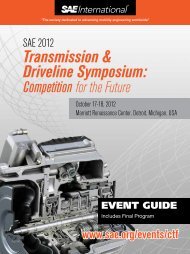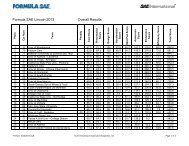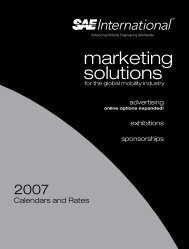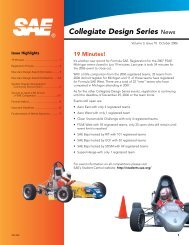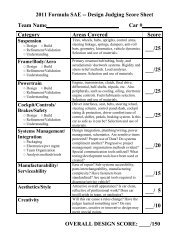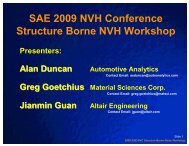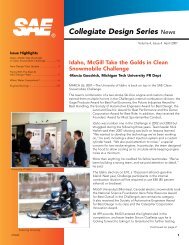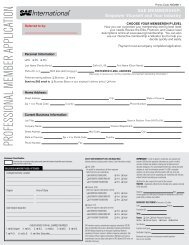Formula SAE A Guide to Meeting the Structure Equivalency ...
Formula SAE A Guide to Meeting the Structure Equivalency ...
Formula SAE A Guide to Meeting the Structure Equivalency ...
Create successful ePaper yourself
Turn your PDF publications into a flip-book with our unique Google optimized e-Paper software.
3.3.6.2 Front Bulkhead Support<br />
For tubular front bulkhead supports where diameter or wall thickness are being varied<br />
equivalency can be shown by comparing section areas, moments of inertia and material<br />
properties of <strong>the</strong> design outlined in <strong>the</strong> rules and <strong>the</strong> new proposed design. Many teams machine<br />
cu<strong>to</strong>uts in <strong>the</strong> front bulkhead support tubes for mounting of <strong>the</strong> suspension links. These cu<strong>to</strong>uts<br />
are allowed. However, when showing equivalency calculations must be presented that show <strong>the</strong><br />
tubes are equivalent <strong>to</strong> <strong>the</strong> baseline steel material at <strong>the</strong> cu<strong>to</strong>uts. The use of gussets and<br />
reinforcing material is allowed and encouraged where needed around <strong>the</strong> suspension cu<strong>to</strong>uts. As<br />
stated in section 3.3.6.2 all tubes comprising <strong>the</strong> bulkhead support must meet <strong>the</strong> minimum and<br />
equivalency must be sought for any and all tubes that deviate from <strong>the</strong> minimum specified in <strong>the</strong><br />
rules.<br />
The rules require node-<strong>to</strong>-node triangulation with at least one diagonal brace on ei<strong>the</strong>r side. In<br />
essence, it is necessary <strong>to</strong> have <strong>the</strong> front bulkhead supported by a triangulated structure. This<br />
may be comprised of one diagonal tube from <strong>the</strong> bulkhead <strong>to</strong> a structural node <strong>to</strong> <strong>the</strong> rear, or a<br />
series of tubes so long as a truss-like structure is formed. If <strong>the</strong>re are any doubts about whe<strong>the</strong>r<br />
a specific configuration meets <strong>the</strong> rules it is suggested a drawing be included with <strong>the</strong> SEF<br />
submission or a rules clarification submitted.<br />
3.3.6.3 Impact Attenua<strong>to</strong>r Attachment (& Anti-Intrusion Plate)<br />
The attachment method of <strong>the</strong> Impact Attenua<strong>to</strong>r (IA) is now called out explicitly as being ei<strong>the</strong>r<br />
welded or attached with a specific number and quality of fasteners. If alternative fastening<br />
methods are used (such as camlock fasteners, six bolts, etc) equivalency will have <strong>to</strong> be shown<br />
<strong>to</strong> <strong>the</strong> fasteners called out in <strong>the</strong> rules. Also, for certain designs of attenua<strong>to</strong>rs a backing plate or<br />
Anti-Intrusion Plate (AIP) is now required. This plate can sit sandwiched between <strong>the</strong> IA and <strong>the</strong><br />
front bulkhead or be completely integrated in<strong>to</strong> <strong>the</strong> IA, but it must be secured with <strong>the</strong> fasteners<br />
(or <strong>the</strong> processes shown <strong>to</strong> have equivalency) called out in <strong>the</strong> rules.<br />
Your Anti-Intrusion Plate can be of a different design but you will have <strong>to</strong> show it is equivalent <strong>to</strong><br />
<strong>the</strong> AIP in <strong>the</strong> rule. If made of composite please see <strong>the</strong> composites section under “General”<br />
near <strong>the</strong> end of <strong>the</strong> document for additional guidelines.<br />
3.3.8.1 Side Impact Protection Material<br />
A simple way <strong>to</strong> show equivalency for metallic tubular side impact structures is <strong>to</strong> use section<br />
properties for <strong>the</strong> complete Side Impact Protection system. Remember that moment of inertia<br />
and area are both required. Do a comparison <strong>to</strong> three steel tubes at <strong>the</strong> same span between<br />
your Roll Hoops. Some teams have also done testing on sample sections <strong>to</strong> verify and/or<br />
determine <strong>the</strong> structure strength. Make sure <strong>to</strong> check any questionable locations of <strong>the</strong> structure<br />
where peak stresses could occur. Normally <strong>the</strong> worst location is midspan of <strong>the</strong> longest tube.<br />
For simple geometries hand calculations should be sufficient. For more complex geometry, finite<br />
element analysis might be required. If <strong>the</strong> side impact structure is attached <strong>to</strong> <strong>the</strong> vehicle, such<br />
as <strong>the</strong> case of a composite sandwich panel attached <strong>to</strong> a steel space frame, you must also show<br />
<strong>the</strong> attachment method is stronger than <strong>the</strong> crush strength of <strong>the</strong> impact structure. This<br />
attachment strength is critical and requires proof with your submission, especially when using<br />
composite panels attached <strong>to</strong> a steel space frame.<br />
SEF_<strong>Guide</strong>_2008.doc / B. Riley 5 11/6/2007



